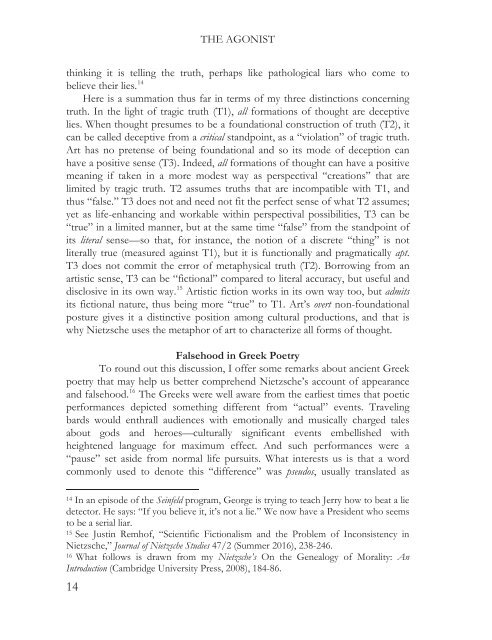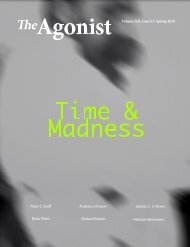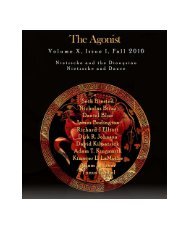Volume XI, Issue II, Spring 2018
Create successful ePaper yourself
Turn your PDF publications into a flip-book with our unique Google optimized e-Paper software.
THE AGONIST<br />
thinking it is telling the truth, perhaps like pathological liars who come to<br />
believe their lies. 14<br />
Here is a summation thus far in terms of my three distinctions concerning<br />
truth. In the light of tragic truth (T1), all formations of thought are deceptive<br />
lies. When thought presumes to be a foundational construction of truth (T2), it<br />
can be called deceptive from a critical standpoint, as a “violation” of tragic truth.<br />
Art has no pretense of being foundational and so its mode of deception can<br />
have a positive sense (T3). Indeed, all formations of thought can have a positive<br />
meaning if taken in a more modest way as perspectival “creations” that are<br />
limited by tragic truth. T2 assumes truths that are incompatible with T1, and<br />
thus “false.” T3 does not and need not fit the perfect sense of what T2 assumes;<br />
yet as life-enhancing and workable within perspectival possibilities, T3 can be<br />
“true” in a limited manner, but at the same time “false” from the standpoint of<br />
its literal sense—so that, for instance, the notion of a discrete “thing” is not<br />
literally true (measured against T1), but it is functionally and pragmatically apt.<br />
T3 does not commit the error of metaphysical truth (T2). Borrowing from an<br />
artistic sense, T3 can be “fictional” compared to literal accuracy, but useful and<br />
disclosive in its own way. 15 Artistic fiction works in its own way too, but admits<br />
its fictional nature, thus being more “true” to T1. Art’s overt non-foundational<br />
posture gives it a distinctive position among cultural productions, and that is<br />
why Nietzsche uses the metaphor of art to characterize all forms of thought.<br />
Falsehood in Greek Poetry<br />
To round out this discussion, I offer some remarks about ancient Greek<br />
poetry that may help us better comprehend Nietzsche’s account of appearance<br />
and falsehood. 16 The Greeks were well aware from the earliest times that poetic<br />
performances depicted something different from “actual” events. Traveling<br />
bards would enthrall audiences with emotionally and musically charged tales<br />
about gods and heroes––culturally significant events embellished with<br />
heightened language for maximum effect. And such performances were a<br />
“pause” set aside from normal life pursuits. What interests us is that a word<br />
commonly used to denote this “difference” was pseudos, usually translated as<br />
14 In an episode of the Seinfeld program, George is trying to teach Jerry how to beat a lie<br />
detector. He says: “If you believe it, it’s not a lie.” We now have a President who seems<br />
to be a serial liar.<br />
15 See Justin Remhof, “Scientific Fictionalism and the Problem of Inconsistency in<br />
Nietzsche,” Journal of Nietzsche Studies 47/2 (Summer 2016), 238-246.<br />
16 What follows is drawn from my Nietzsche’s On the Genealogy of Morality: An<br />
Introduction (Cambridge University Press, 2008), 184-86.<br />
14









